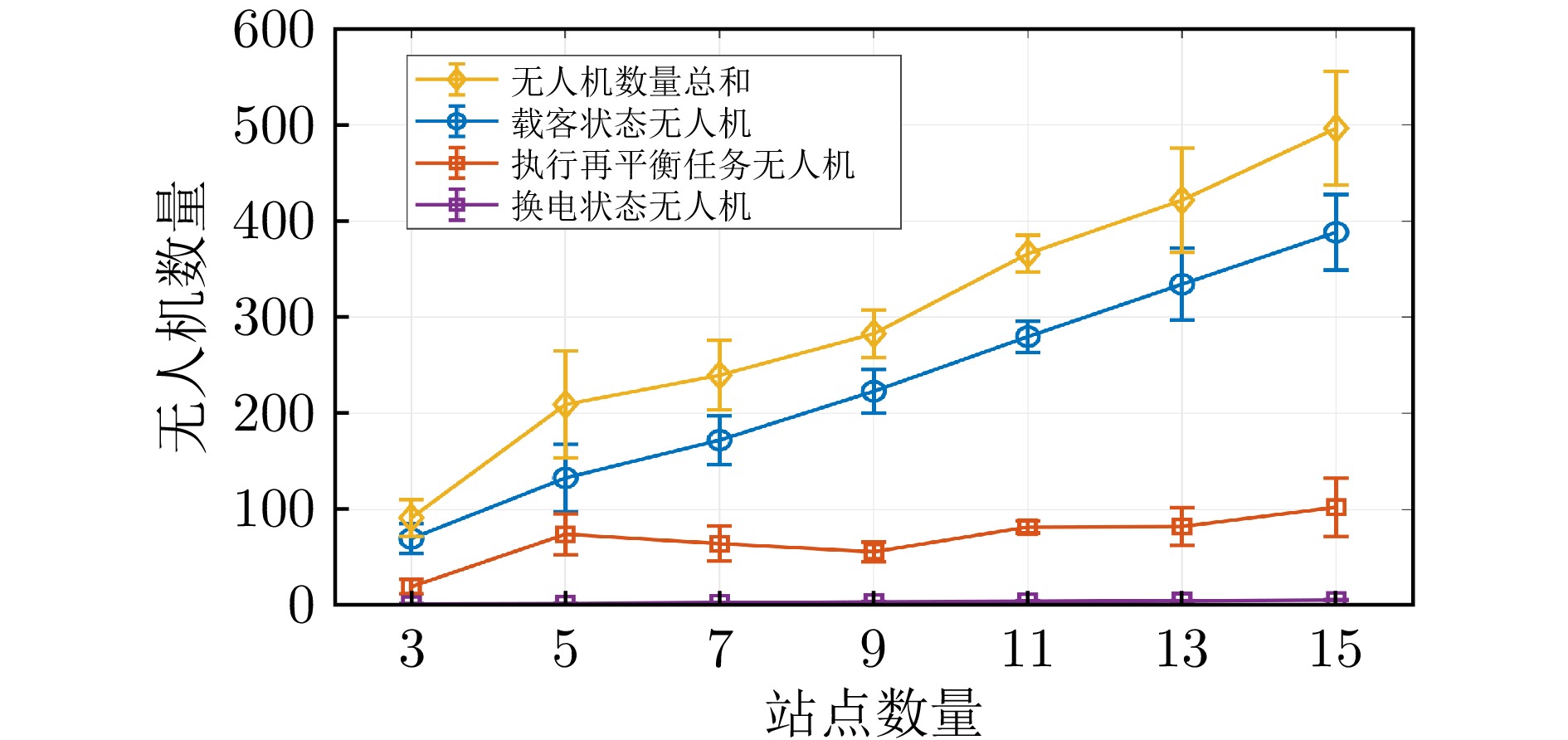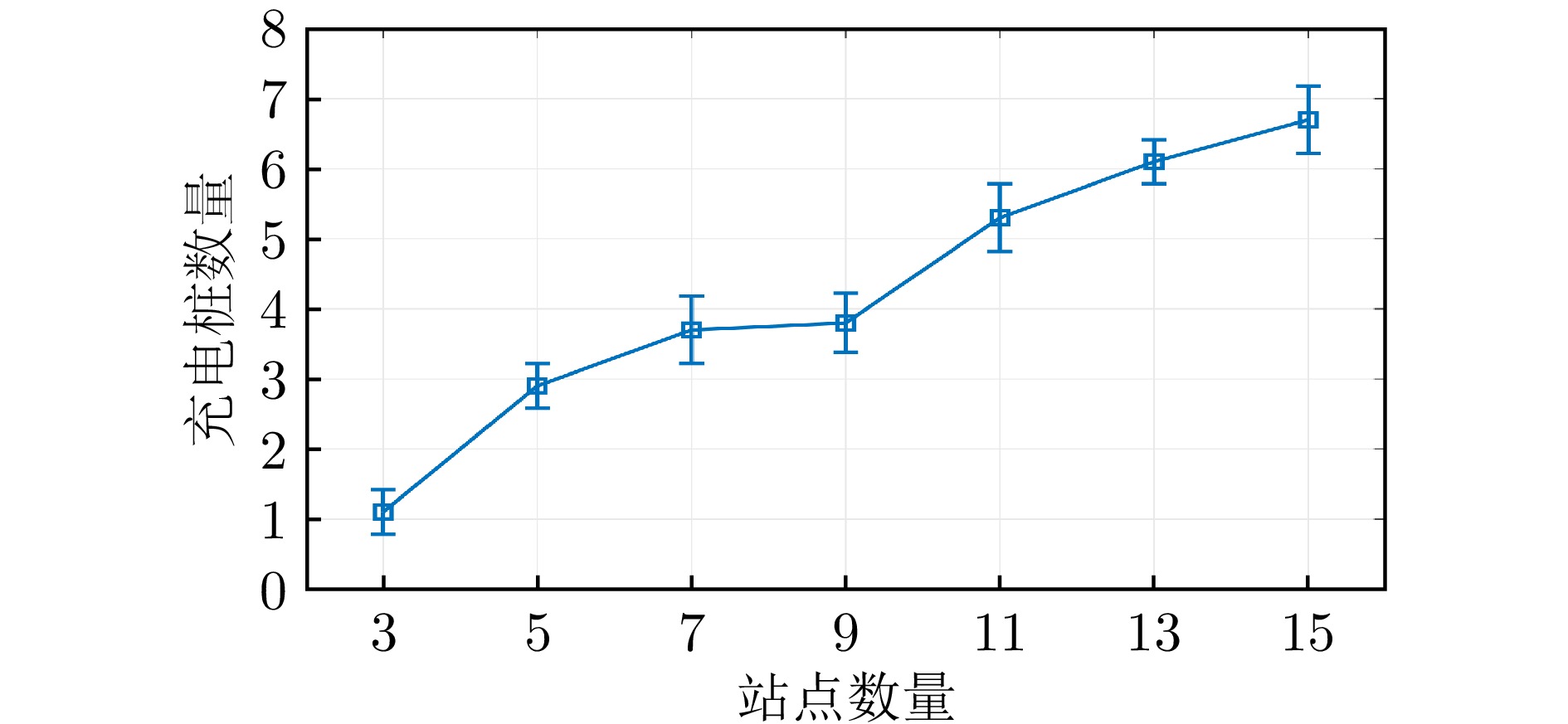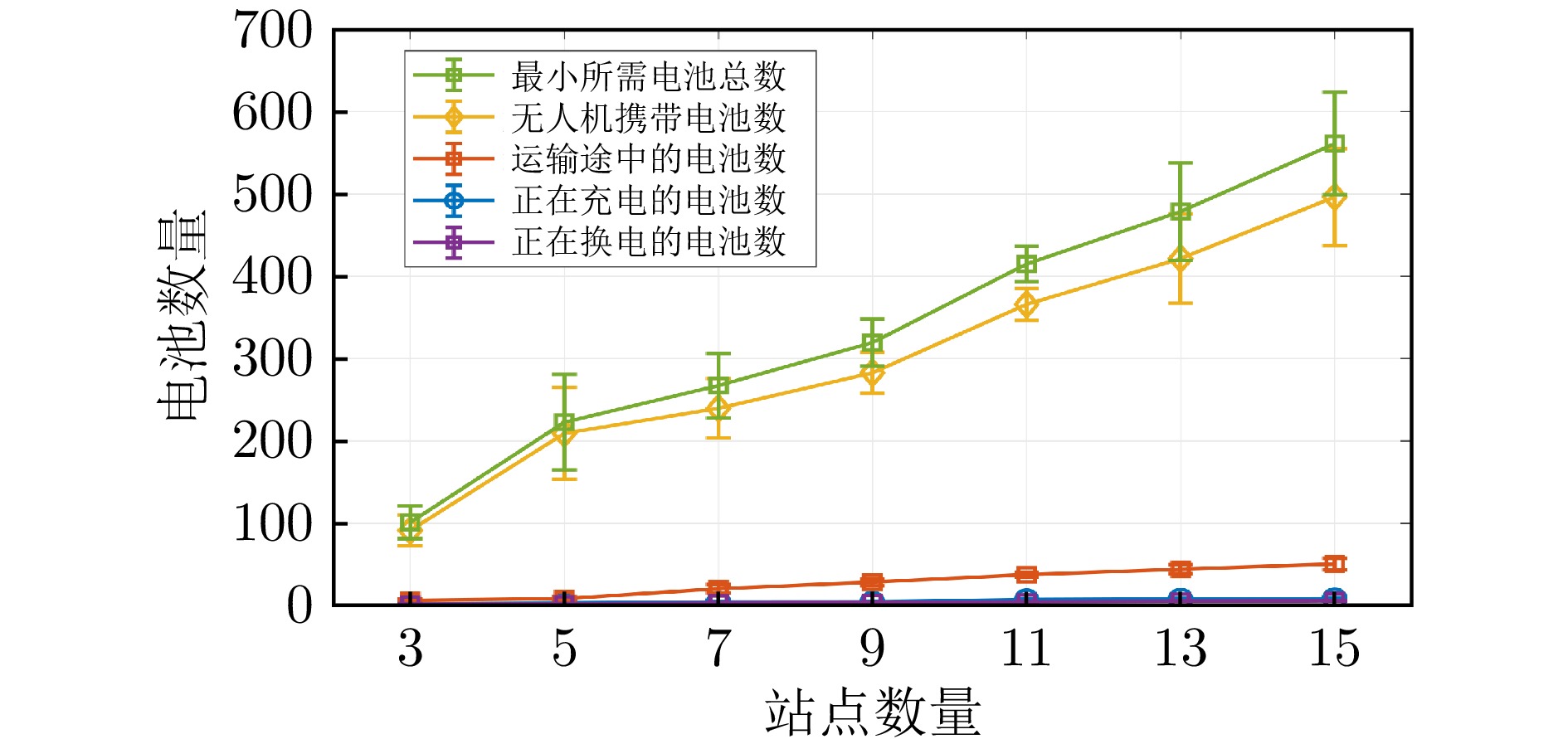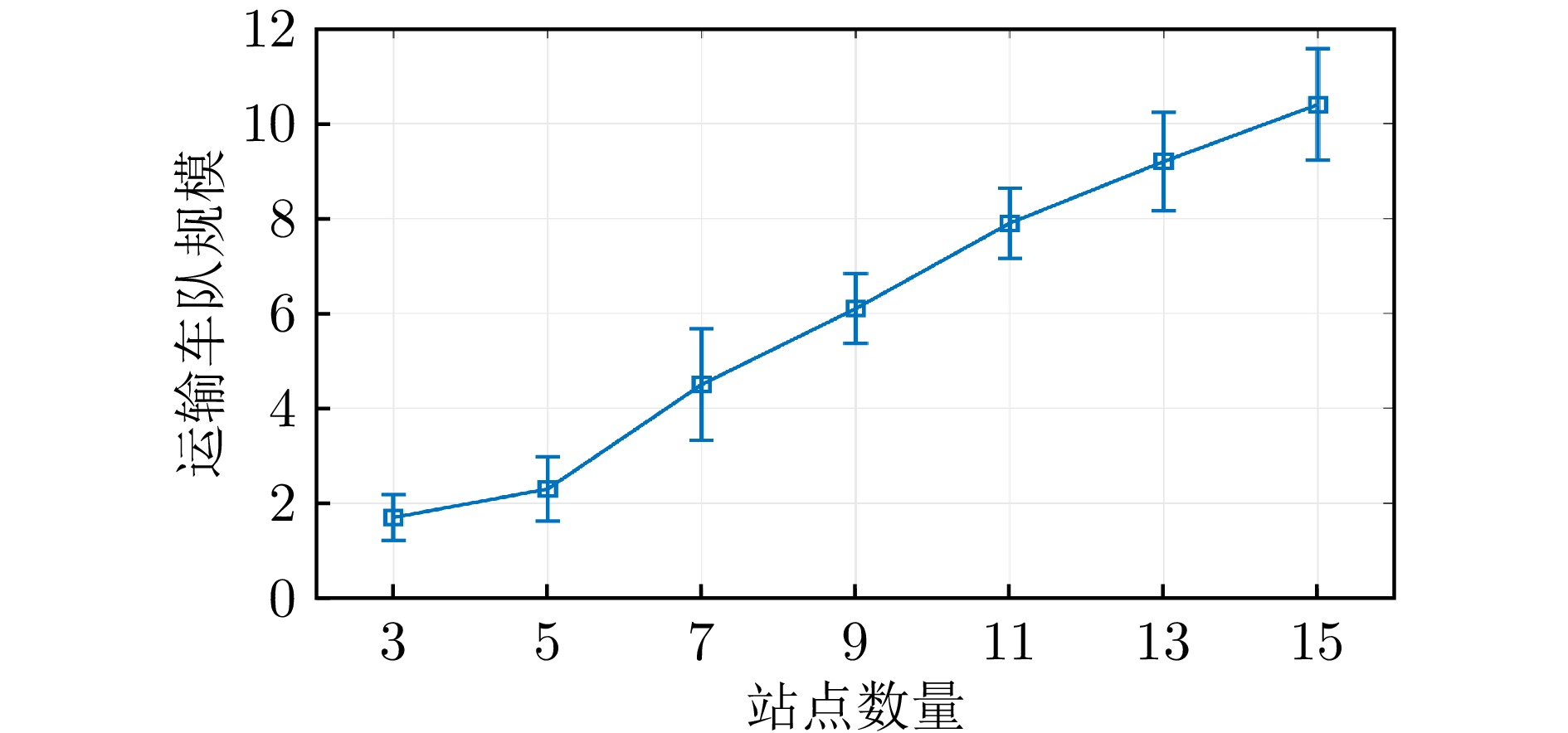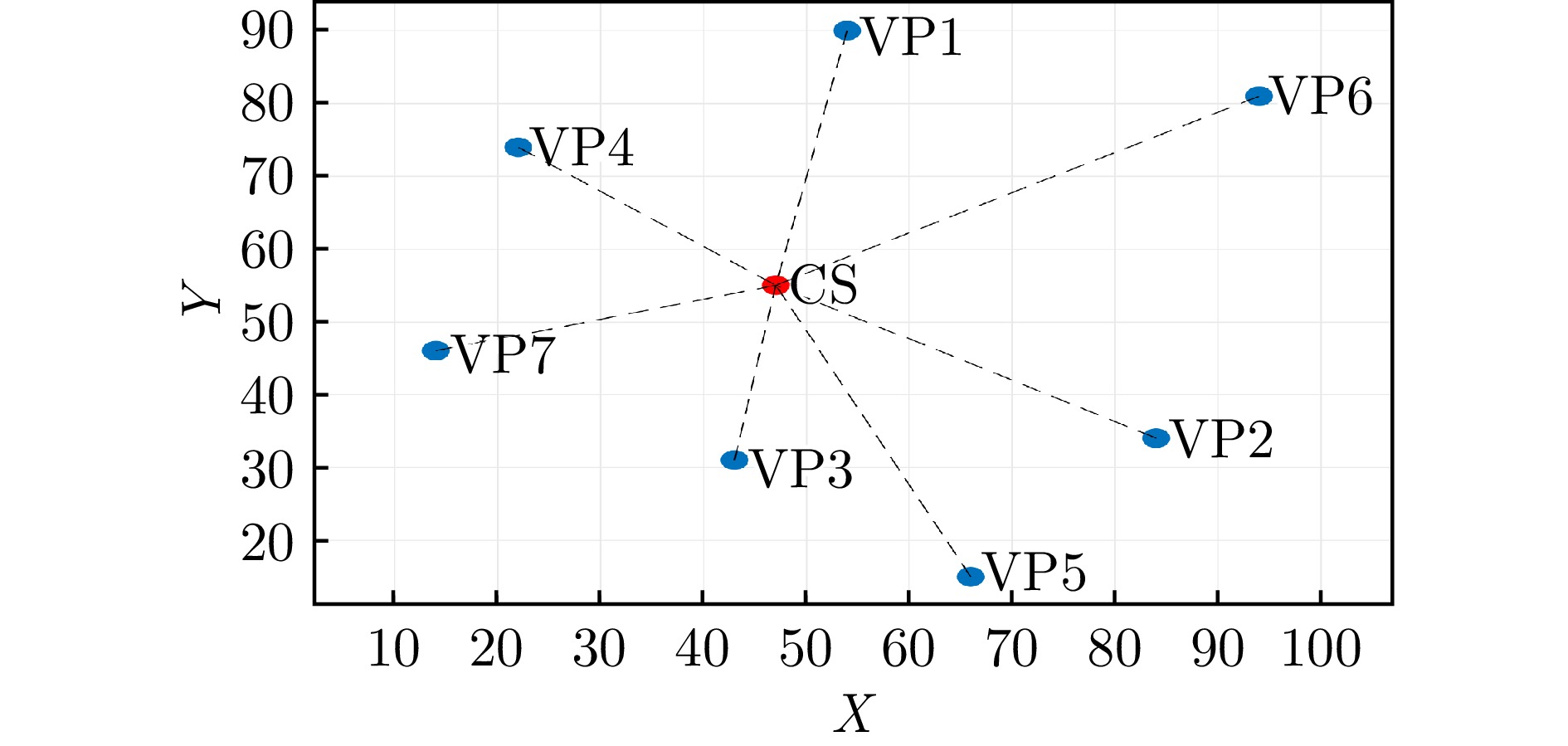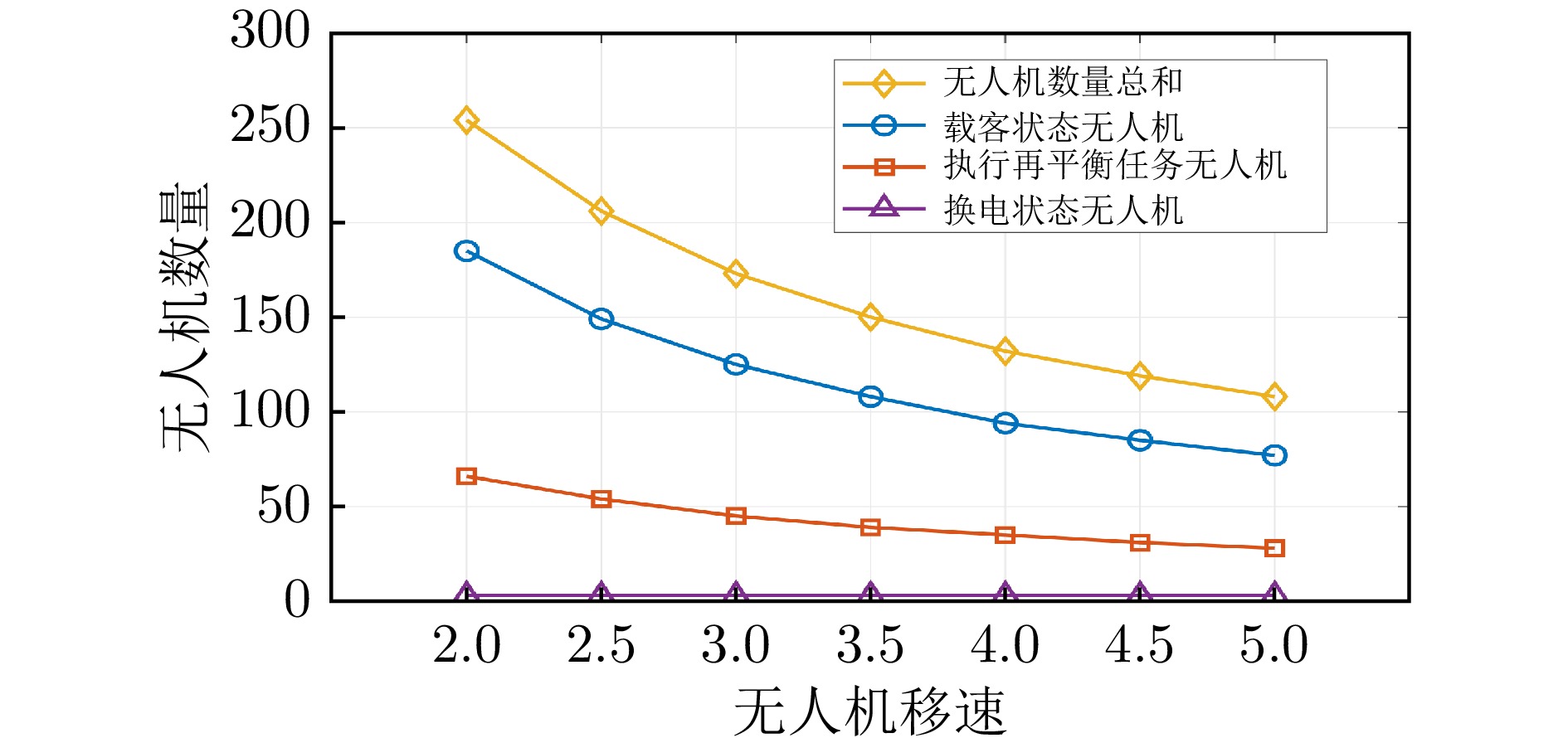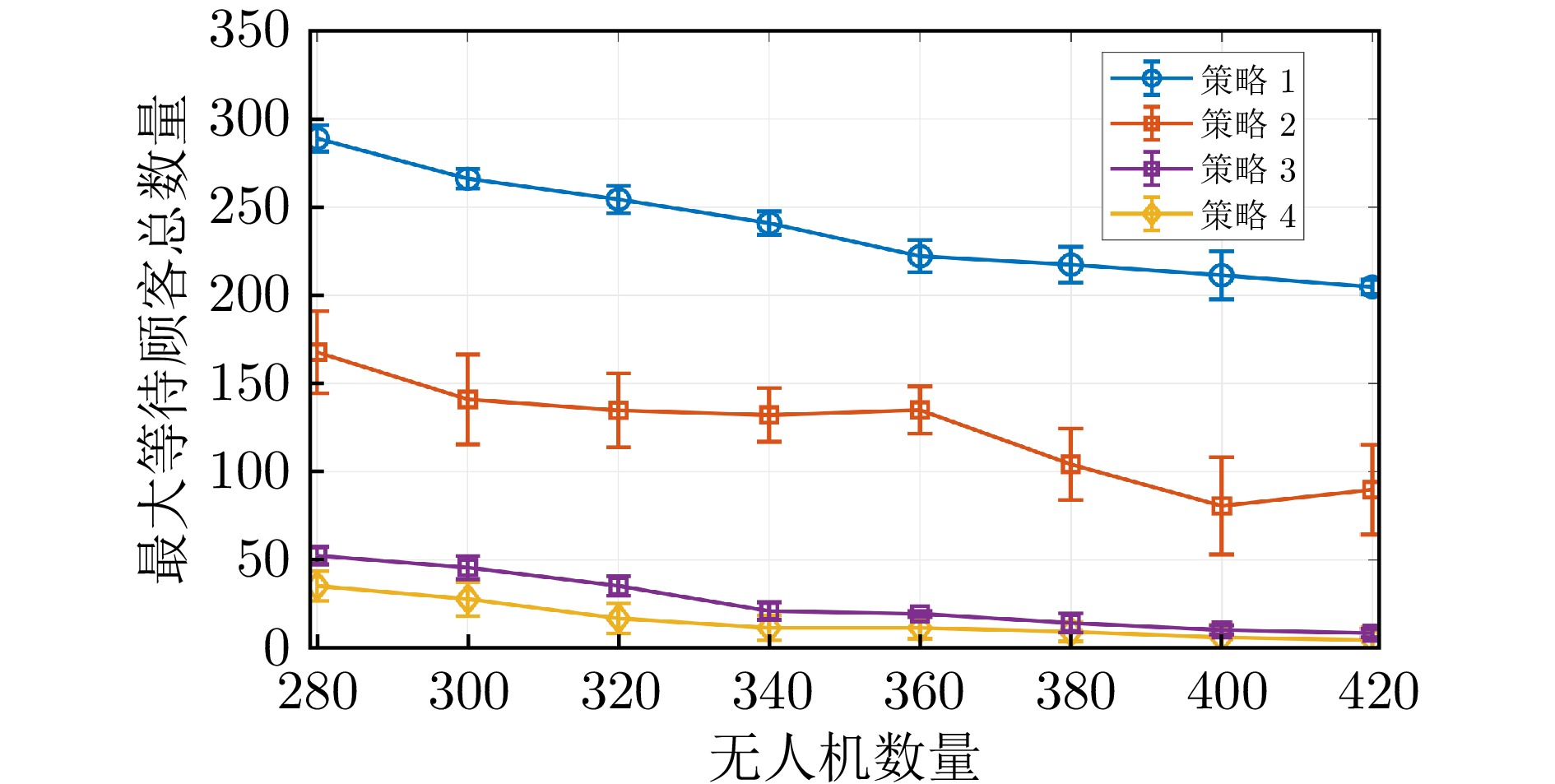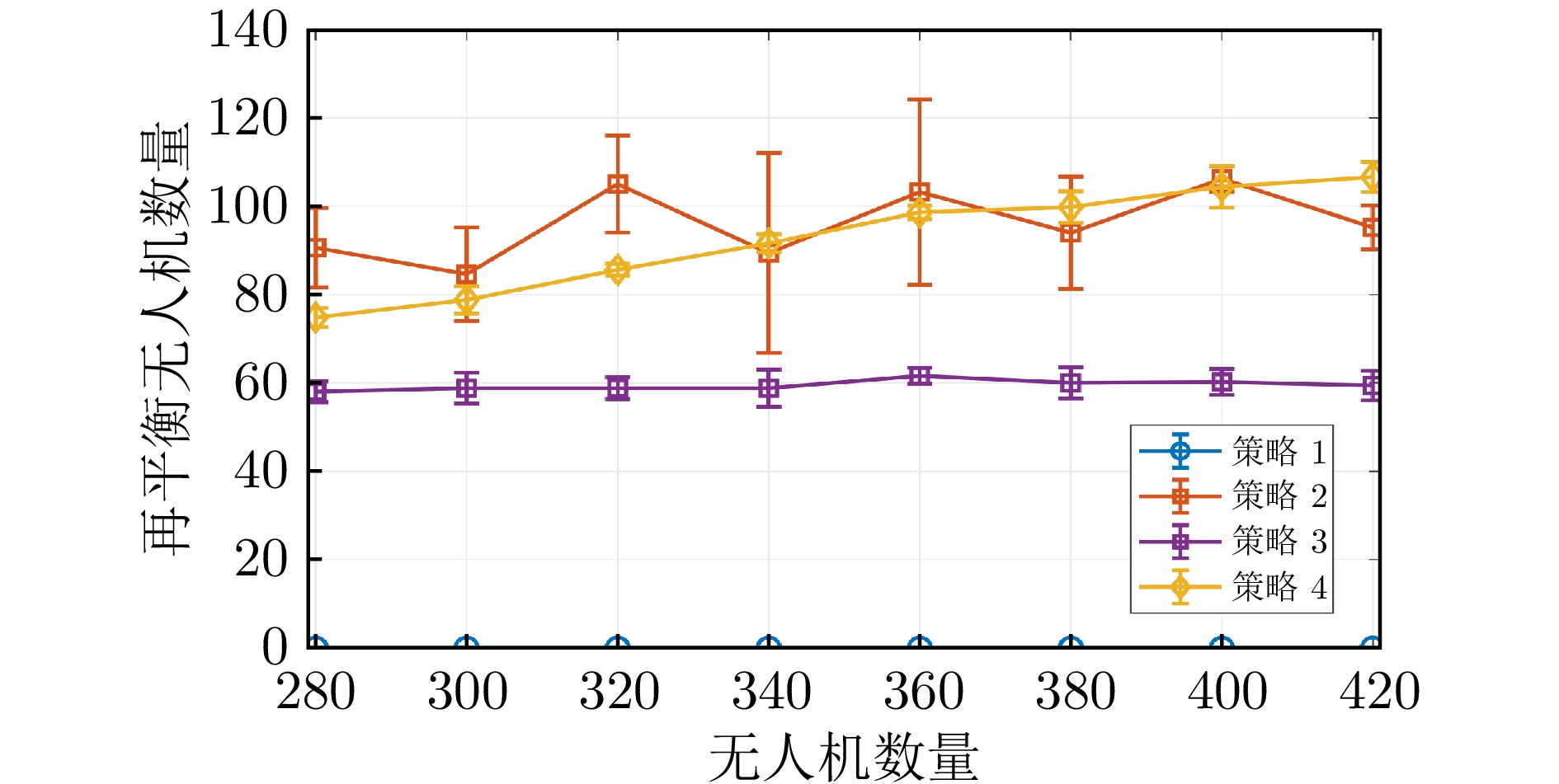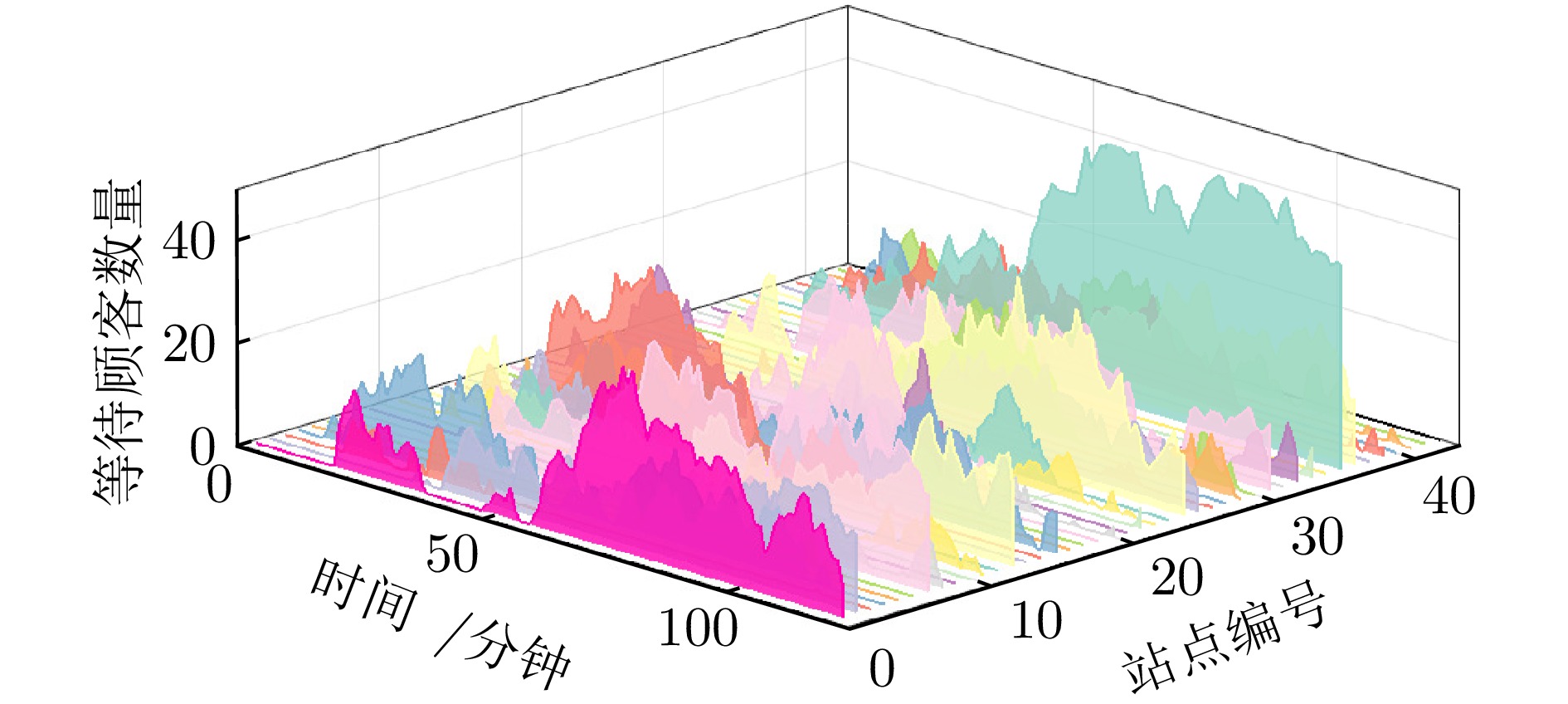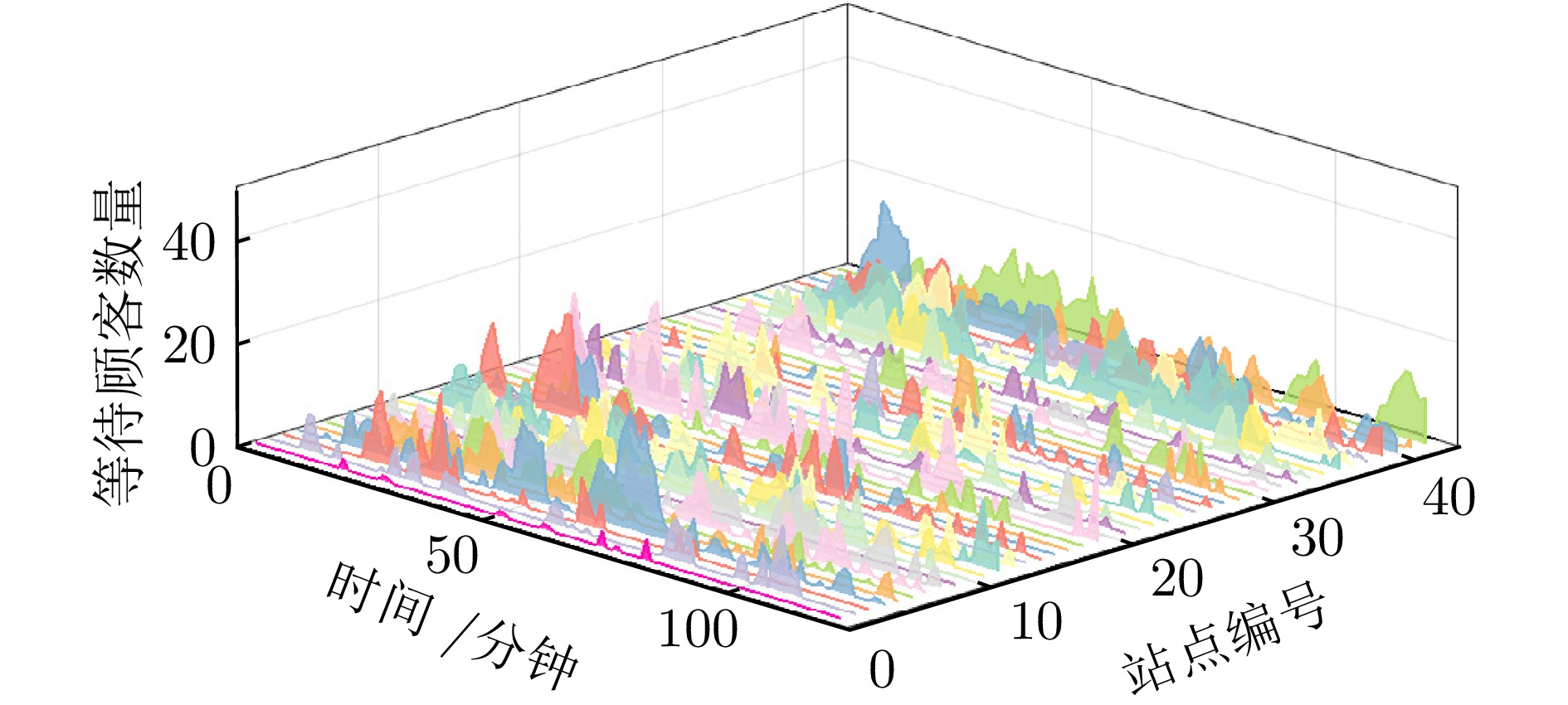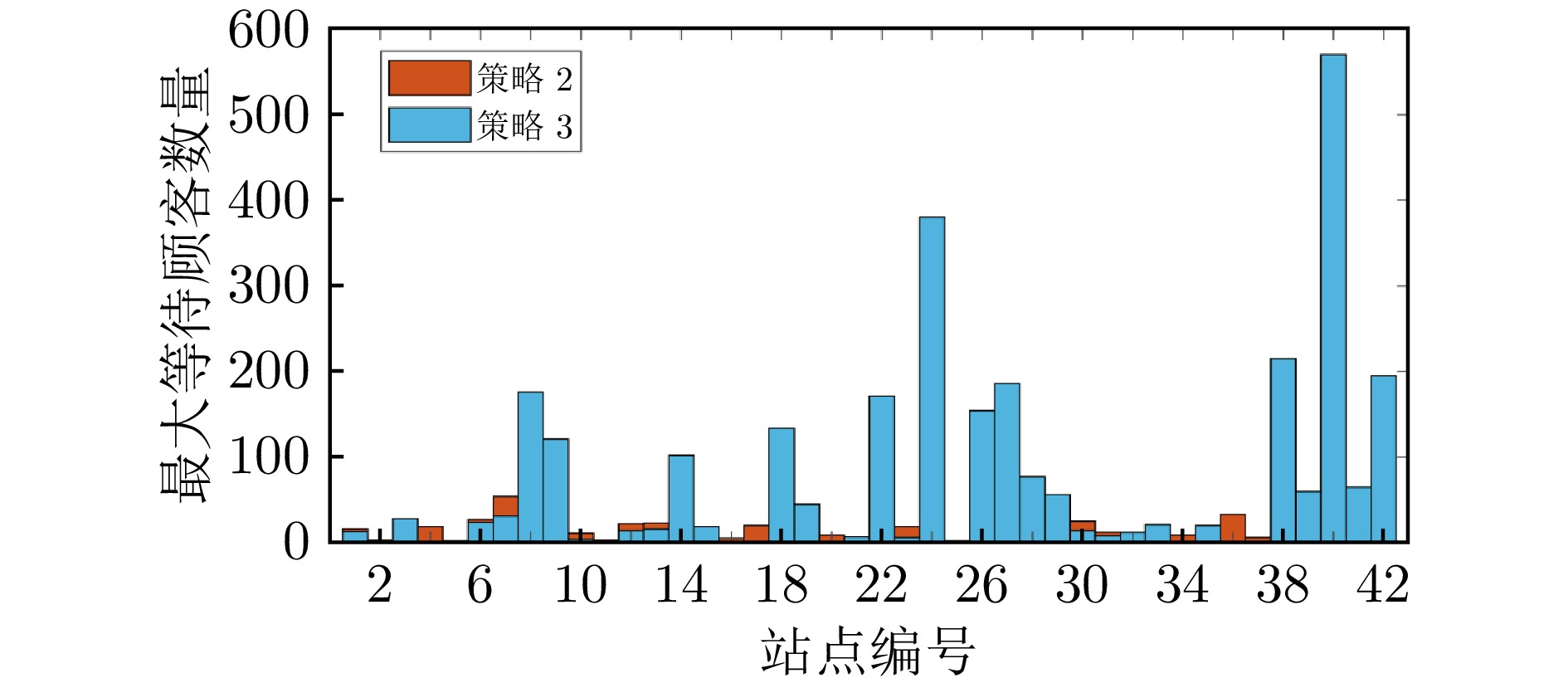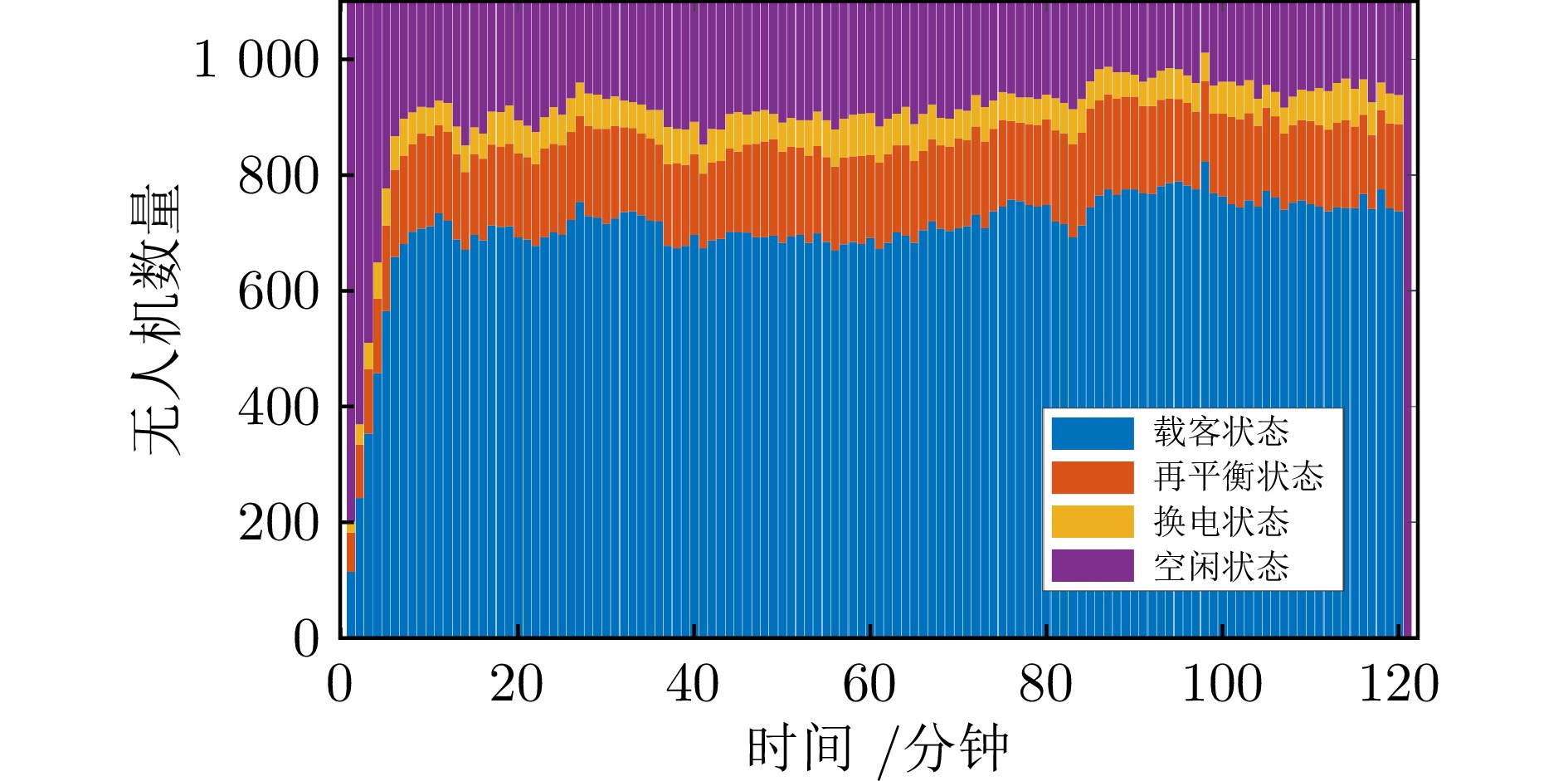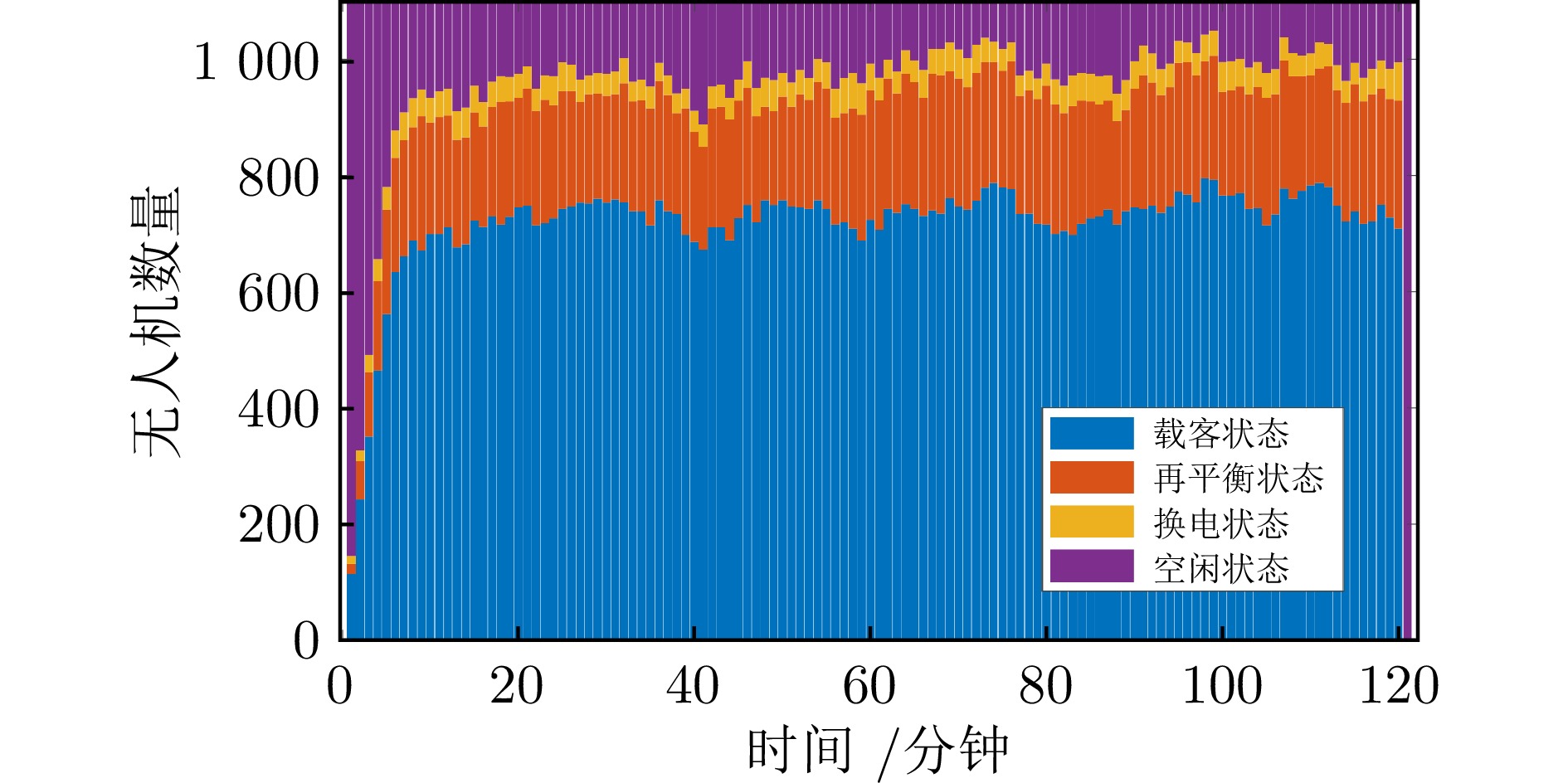-
摘要: 针对城市空中交通系统,提出一种优化方法以同时确定满足乘客需求的最小系统规模和最佳系统再平衡策略.研究构建了流体模型与多服务器M/M/s排队模型的联合框架,描述乘客、飞行器与电池在站点间迁移、换电及充电过程.在该模型框架下对飞行器和电池数量的适定性进行了证明,并给出了系统供需均衡时的必要条件.在此基础上,通过线性规划求解系统供需均衡下的再平衡分配率与最小机队规模,并计算最优充电站位置、电池数量及电池运输车数量.数值仿真分析了影响系统规模的因素,实例验证证明了所提再平衡方法的有效性.Abstract: This paper focuses on urban air mobility systems and proposes an optimization method to simultaneously determine the minimum system scale required to meet passenger demand and the optimal system rebalancing strategy. A combined framework consisting of fluid model and multi-server M/M/s queueing model is developed to capture the migration of passengers, aircraft, and batteries among stations, as well as battery swapping and charging processes. Within this framework, the well-posedness of the numbers of aircraft and batteries is proven, and the necessary conditions for supply–demand equilibrium are derived. On this basis, linear programming is employed to compute the rebalancing allocation rates and the minimum fleet size under supply-demand equilibrium, and to determine the optimal locations of charging stations, the number of batteries, and the number of battery transport vehicles. Numerical simulations analyze the factors affecting system scale, and a case study verifies the effectiveness of the proposed rebalancing method.
-
Key words:
- Urban air mobility /
- aircraft /
- system scale /
- rebalancing scheduling /
- supply–demand balance
-
表 1 载人飞行器系统符号说明
Table 1 Symbol description of the passenger eVTOL system
符号 定义 $ \lambda_i $ 乘客在站点$ i $请求服务的速率 $ \lambda_i^{'} $ 飞行器在站点$ i $请求换电的速率 $ \lambda_{cs} $ 充电站接收低电量电池的速率 $ p_{ij} $ 站点$ i $中的乘客将要前往站点$ j $的比例 $ \mu_i $ 站点$ i $中飞行器分配给乘客的速率 $ \mu_{cs}^{'} $ 充电站中每个充电桩的服务率 $ s_{cs} $ 充电站中充电桩的数量 $ D_{cs} $ 电池停留在充电站中的平均时间 $ T_{ij} $ 站点$ i $到站点$ j $的飞行耗时 $ v_{ic} $ 运输车的行驶速度 $ o_{cs}^i $ 充电站中的电池发往站点$ i $的比例 $ c_{i} $ 当前时刻站点$ i $中的乘客数 $ e_{i} $ 当前时刻站点$ i $中的飞行器数 $ b_{i} $ 当前时刻站点$ i $中的电池数 $ c_j^{i} $ 时刻$ T_{ij} $之前站点$ j $中的乘客数 $ e_j^{i} $ 时刻$ T_{ij} $之前站点$ j $中的飞行器数 $ b_{ji}^{k} $ 时刻$ (T_{ij}+D_{cs}) $之前站点$ j $中的电池数 -
[1] Shahriar Ahmed S, Fountas G, Lurkin V, Anastasopoulos P, Zhang Y, Bierlaire M, et al. The state of urban air mobility research: An assessment of challenges and opportunities. IEEE Transactions on Intelligent Transportation Systems, 2025, 26(2): 1375−1394 doi: 10.1109/TITS.2024.3511453 [2] Cohen A P, Shaheen S A, Farrar E M. Urban air mobility: History, ecosystem, market potential, and challenges. IEEE Transactions on Intelligent Transportation Systems, 2021, 22(9): 6074−6087 doi: 10.1109/TITS.2021.3082767 [3] Rajendran S, Srinivas S. Air taxi service for urban mobility: A critical review of recent developments, future challenges, and opportunities. Transportation Research Part E: Logistics and Transportation Review, 2020, 143: Article No. 102090 doi: 10.1016/j.tre.2020.102090 [4] Wang K, Qu X. Urban aerial mobility: Reshaping the future of urban transportation. The Innovation, 2023, 4(2): Article No. 100392 doi: 10.1016/j.xinn.2023.100392 [5] Bulusu V, Onat E B, Sengupta R, Yedavalli P, Macfarlane J. A traffic demand analysis method for urban air Mmobility. IEEE Transactions on Intelligent Transportation Systems, 2021, 22(9): 6039−6047 doi: 10.1109/TITS.2021.3052229 [6] Zhang J, Qin X, Zhang M. Multi-aircraft scheduling optimization in urban environments. Applied Mathematical Modelling, 2025, 145: Article No. 116118 doi: 10.1016/j.apm.2025.116118 [7] Zhang H, Liu Z, Dong Y, Zhou H, Liu P, Chen J. A novel network equilibrium model integrating urban aerial mobility. Transportation Research Part A: Policy and Practice, 2024, 187: Article No. 104160 doi: 10.1016/j.tra.2024.104160 [8] Shim J, Park J, Song N C, Jang J, Choi J Y, Lee G, et al. Real-time optimal route planning by deep reinforcement learning and validation with flight test. In: AIAA AVIATION 2023 FORUM. Amer Inst Aeronautics & Astronautics; 2023 [9] He X, He F, Li L, Zhang L, Xiao G. A route network planning method for urban air delivery. Transportation Research Part E: Logistics and Transportation Review, 2022, 166: Article No. 102872 doi: 10.1016/j.tre.2022.102872 [10] Tang H, Zhang Y, Mohmoodian V, Charkhgard H. Automated flight planning of high-density urban air mobility. Transportation Research Part C: Emerging Technologies, 2021, 131: Article No. 103324 doi: 10.1016/j.trc.2021.103324 [11] 钟罡, 华骏鸣, 杜森, 刘玉璞, 刘皞, 张洪海. 基于复杂网络的城市低空飞行计划优化调度. 航空学报, 2025, 46(11): Article No. 531479Zhong G, Hua J, Du S, Liu Y, Liu H, Zhang H. Urban low-altitude flight plan optimal scheduling based on complex network. Acta Aeronautica et Astronautica Sinica, 2025, 46(11): Article No. 531479 [12] Espejo-Díaz J A, Alfonso-Lizarazo E, Montoya-Torres J R. A heuristic approach for scheduling advanced air mobility aircraft at vertiports. Applied Mathematical Modelling, 2023, 123: 871−890 doi: 10.1016/j.apm.2023.07.009 [13] Li S, Zhang T, Xiao Y, Li D. On-demand ridesharing based on dynamic scheduling in urban air mobility. Transportation Research Part C: Emerging Technologies, 2025, 175: Article No. 105111 doi: 10.1016/j.trc.2025.105111 [14] Boddupalli S S, Garrow L A, German B J, Newman J P. Mode choice modeling for an electric vertical takeoff and landing (eVTOL) air taxi commuting service. Transportation Research Part A: Policy and Practice, 2024, 181: Article No. 104000 [15] Ilahi A, Belgiawan P F, Balac M, Axhausen K W. Understanding travel and mode choice with emerging modes: A pooled SP and RP model in Greater Jakarta, Indonesia. Transportation Research Part A: Policy and Practice, 2021, 150: 398−422 doi: 10.1016/j.tra.2021.06.023 [16] Shon H, Lee J. An optimization framework for urban air mobility (UAM) planning and operations. Air Transport Management, 2025, 124: Article No. 102720 doi: 10.1016/j.jairtraman.2024.102720 [17] Lv D, Zhang W, Wang K, Hao H, Yang Y. Urban aerial mobility for airport shuttle service. Transportation Research Part A: Policy and Practice, 2024, 188: Article No. 104202 doi: 10.1016/j.tra.2024.104202 [18] Pei Z, Fang T, Weng K, Yi W. Urban On-demand delivery via autonomous aerial mobility: Formulation and exact algorithm. IEEE Transactions on Automation Science and Engineering, 2023, 20(3): 1675−1689 [19] Kai W, Jacquillat A, Vaze V. Vertiport Planning for urban aerial mobility: An adaptive discretization approach. Manufacturing & Service Operations Management, 2022, 24(6): 3215−3235 [20] Bennaceur M, Delmas R, Hamadi Y. Passenger-centric urban air mobility: fairness trade-offs and operational efficiency. Transportation Research Part C: Emerging Technologies, 2022, 136: Article No. 103519 [21] Guo G, Xu T. Vehicle rebalancing with charging scheduling in one-way car-sharing systems. IEEE Transactions on Intelligent Transportation Systems, 2022, 23(5): 4342−4351 doi: 10.1109/TITS.2020.3043594 [22] Pavone M, Smith S, Frazzoli E, Rus D. Robotic load balancing for mobility-on-demand systems. Robotics Research, 2012, 31: 839−854 doi: 10.1177/0278364912444766 -

计量
- 文章访问数: 41
- HTML全文浏览量: 26
- 被引次数: 0



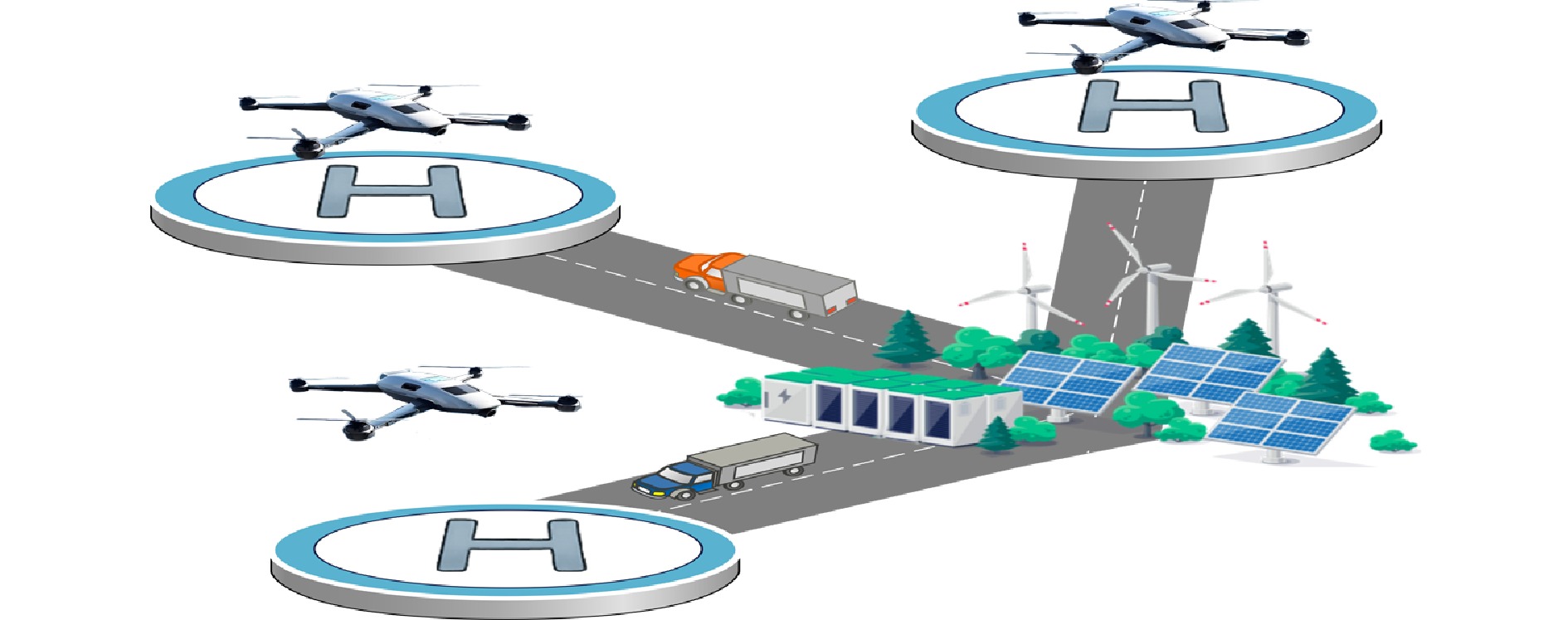
 下载:
下载:
